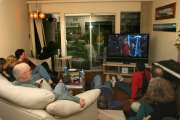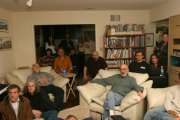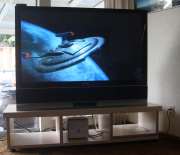
Brad Templeton Home
(My Blog)
ClariNet
|
|
Story of the Superbowl Commercials Party
(For comments etc. on this item, go to its entry in my blog.)
On Feb 6, 2005, I held my third annual Superbowl Commercials party. Not a superbowl party, since we barely watch the football. Instead we watch only the commercials. And why not -- at 2 million dollars for 30 seconds, they put a lot of effort into making those commercials memorable and entertaining.
In the past I've used a Tivo, but today used an "open-source" similar system called MythTV. These boxes record a TV show to a computer hard disk, and then you can play it back just as you like, with lots of clean fast forward and rewind speeds, instantaneous jumps (either short or long) and much more. Unlike a video tape, you can watch a show while it is being recorded, since one program is adding more video to the file and another program is playing it from an earlier spot. Some people use this to pause live TV, and many use it to skip boring parts of programs, particularly commercials.
 |
| football-cheer-on-hilltop.jpg (1280 x 853 - 73K) |
This time we did it in reverse -- we fast forwarded over the football game and slowed down to watch the commercials. Each year, the party has begun around kickoff time by heading out for a hike, in opposition to the couch potato lifestyle being promoted that day. In good weather we hike in the mountains; in 2004 we just walked to a local football field, and while it was tempting to be the only people out playing football that day, we just jogged around the track and went back.
 |
| hikers-on-hilltop.jpg (1280 x 853 - 72K) |
We do the hike at the start of the game so the recorder has an hour or two to "buffer" the show. We're going to be watching super-fast, so if things aren't timed perfectly, we might well catch up with the live showing if we're not careful, and thus lose our ability to fast-forward.
After we get home, we begin with some of the music and national anthems, and then the game begins -- and I hit the fast forward key. Moving at about 20 times normal speed works fine. You can actually follow the action on the screen as the players dance up and down the field. The networks put a score box on the screen all the time, so if there is a scoring play, you can see it right away, and then rewind (or rather instantly seek back -- you are not really winding anything) and watch it again at normal speed if you like.
Normally when using such a box, you get a reflex to zoom over boring ads, but in the superbowl you must unlearn that reflex, as a commercial is a sign it's time to go back to normal playback. This may be a hint for advertisers. We have this party because the superbowl commercials have a reputation for being entertaining, and not repeating too much. Some day, programs may demand that their commercials be of a certain quality, because that demand would cause viewers not to skip the commercials, making them more useful for the advertisers.
The commercials are good, but in a crowd of friends, with alcohol consumed, they're great. Like watching a movie in a crowded cinema full of laughing people instead of alone at home, you enjoy it more. The crowd fell on the floor at Ameriquest's cat-killer ad, and I had to replay a few ads we could not hear over the laughter. (Last year the main replay request came at the end of Janet Jackson's song for some reason.) We liked Fedex's ad, a parody of other ads, the best. But then, we were in it for the ads. And these ads, starting with Apple Computer's 1984 spot, have become part of our culture.
MythTV
There is an important story as well about the technology behind this. The first 2 years I used the Tivo, which is a great box, but limited compared to MythTV, which is an open source (free) system used primarily on the Linux free operating system. MythTV is able to record high definition TV, which was a must for me, since the game and many of the ads were in high-def. I had resisted getting an HDTV for several years because once you use a box like the Tivo, you can never go back and watch TV the old way again. It just bugs you. But until recently there were no boxes like that for HDTV. Now Tivo offers one if you use DirecTV, and some inferior ones are offered by some cable and satellite companies.
All of these boxes are "locked up" like a car sold with the hood welded shut. MythTV comes with all the source code. Many people are inclined to tinker with it, but even if that's not for you, a crowd of tinkerers are literally adding new features to it for you every day. Tivo, on the other hand, has had just 4 major releases, and a much smaller number of new features -- and Tivo is the best of the locked up HDRs (Hard Disk Recorders.) I know, I'm building some of those new features myself. For example, I am testing a new system called TVWish which down the road could change the whole nature of how we choose what to watch.
At my party, it was very high-tech. An antenna on the roof fed the FOX HDTV signal coming over the air into a tuner card located in a server computer in my workroom. This computer ran the MythTV "backend" and did the fairly simple task of recording the video stream to the disk.
Another computer sat in my living room next to the HDTV. This was the "frontend." On my commands, it connected to the computer upstairs over my house internet and pulled down the video file at the time point we were watching. HDTV was literally coming into the living room over ethernet, and it felt very 21st century.
During one high-tech moment, it was also clear that the TV was really a computer display. After the buxom Godaddy censorship parody, somebody commented that Godaddy had a different ad that had gotten refused by Fox and it was on their web site. A few clicks and I had the Firefox browser on my screen. With my 6 megabit connection, I installed the latest Flash player in about 10 seconds and was quickly playing the refused ad. Then it was back to our regularly scheduled commercials.
 |
| paul-sings.jpg (1280 x 853 - 105K) |
Normally the "backend" upstairs does just that, but this time the party was big so we hooked a projector (thanks to Rohit Khare) up to the backend computer and had it temporarily run a frontend. Another group of revelers went upstairs and watched the game at their own pace. They actually watched much faster than we did in the living room, skipping the halftime show and more football. Downstairs, we watched Paul. It was a good thing nobody cared a lot about the football, since half the party-goers "knew the future" from the standpoint of us downstairs.
Midway through, we broke for dinner, paused on a Pepsi ad, had food and conversation and then resumed the game. Or rather the ads.
 |
| crowd-watches-tv.jpg (1280 x 853 - 102K) |
Like last year, it turned out the game was exciting to the end. So when it got down to just a few minutes left, we began to watch the game. Some liked this, some had absolutely no football interest and begged off.
However, we didn't watch it like live people do. If you watch football, you know how the last 2 minutes of play can take 20 minutes. Not with the HDR. We watched the play, but continued to FF over the timeouts and other non-sporting elements. So for us the last 2 minutes were an exciting 4 or so minutes. In fact, HDRs are absolutely great for sports, not simply because you can skip commercials.
And we did skip some commercials. The ones that were repeated. The Mantra in marketing school is you have to show an ad again and again to have an effect. Not with us. Once we saw it was the same, we zoomed over it.
 |
| hdtv.jpg (1024 x 883 - 88K) |
Notice how all you see is the monitor and a computer. The computer does it all. It tunes, records and plays TV and videos, it can be (illegally) a DVD player/importer and CD player/ripper, a DVD and CD recorder, an MP3/Ogg/etc. player and music jukebox, a web browsing, email and weather station and of course a full linux computer. Once you can get Internet Speakers you would not even need an amplifier.
Illegal!
So all this high tech stuff is great, but there's a catch. The tuner card that receives the signal from the TV station and lets the computer write it, in its transmitted form to the hard disk will be illegal to make or import after June of this year, 2005.
Yes, illegal. A card that simply takes an unencrypted stream of data from the public airwaves with a TV show in it, and copies it, unchanged to a disk file. Now, because I already have mine, that one won't become illegal. If you get one now, you can keep it. But nobody will be able to make new ones in the USA after that date.
How did this happen? Somehow the FCC was convinced by powerful lobbyists to put in a regulation forbidding such a basic card. The new "Broadcast Flag" law forbids anybody from selling a system that lets you get at the data that's flowing through the air. If the "flag" is set (as it is expected to be most of the time) any legal tuner is required to block access, and only give the video to other devices that won't let the ordinary user have at it, except on a trusted screen.
So that means if you are a big consumer electronics vendor, willing to make a locked-up box and go through some paperwork, you can make something with a digital TV tuner in it.
But free open source software, along with smaller companies who don't want to have to ask permission to design their products, is caught in a jam. You can't make open source software that locks out its users. The users all have the full original "source" form of the program. They can modify it, and remove any lock you might put in it. In addition, it's vastly, vastly easier to design a system based on ordinary, unencrypted data files. There is a wide range of tools you can use, and you don't jump through complex hoops that are hard to test and make right.
Under the Broadcast Flag rule, only trusted machines can get at the plain old video. That blocks out all sorts of possible features, and almost as bad, forces innovators to get permission from an industry cartel before they can innovate.
We've seen this happen before. The DVD player was built this way. DVD players are great, but you might have noticed that when it comes to playing videos, the ones today are almost identical to the high-end ones that came out 10 years ago -- they are just a lot cheaper. 10 years and almost no innovation -- compare that to other tools like the world wide web, or the MP3 player, or just about anything else. It's frightening.
There is some hope. I'm with the Electronic Frontier Foundation, an online free-speech group, and we're suing the FCC over this. They went way beyond their bailiwick when they tried to regulate and ban ordinary computer and consumer electronics items. There's more at our DTV Liberation Front. We've also filed suits to protect the users of hard disk video players, to stop the studios from calling the users thieves because they do things like skip over a commercial or move the video from one room to another like I did.
Tech Notes
Some have asked what actual hardware was required. Receiving HDTV requires just a card like the pcHDTV-3000 I have or a new one called the Air2PC. Any CPU can handle that simple task. Playback of regular TV can be done on old machines (such as a 600mhz class system) but playback of HDTV requires modern hardware, in this case a 3ghz Pentium-4. Support for the built in mpeg decoders in some video cards is stabilizing, and can allow playback with less CPU.
Future of TV
As you probably note, I am quite interested in the future of TV and media, and I support our efforts at the EFF to defend freedom and innovation in this space. I've written other essays on topics like The Future of TV Advertising including my first introduction to Abridging TV series as is done in TVWish. You may also want to check out an old vision I called Poor Man's Video on Demand.